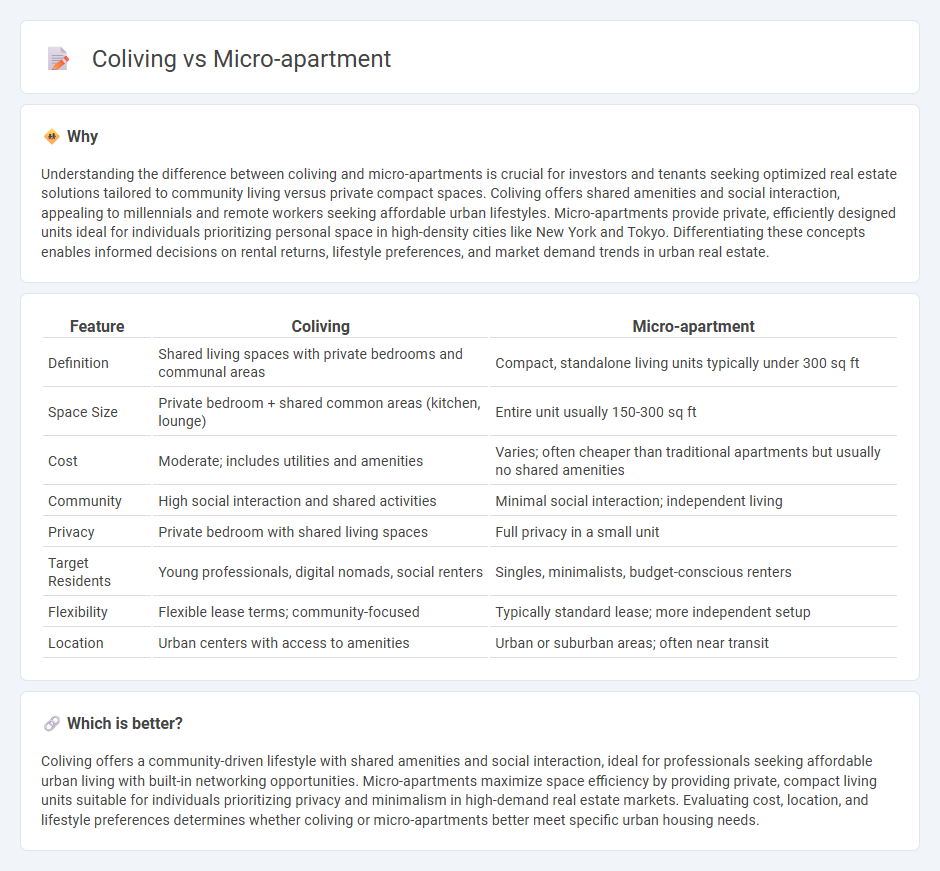
Coliving spaces offer shared amenities and communal living areas designed to foster social interaction, making them ideal for young professionals and digital nomads seeking community and affordability. Micro-apartments maximize limited urban space with compact, self-contained units providing privacy and efficiency, catering to individuals prioritizing independence in high-demand city locations. Explore how these innovative housing trends are reshaping urban living and adapting to modern lifestyle needs.
Why it is important
Understanding the difference between coliving and micro-apartments is crucial for investors and tenants seeking optimized real estate solutions tailored to community living versus private compact spaces. Coliving offers shared amenities and social interaction, appealing to millennials and remote workers seeking affordable urban lifestyles. Micro-apartments provide private, efficiently designed units ideal for individuals prioritizing personal space in high-density cities like New York and Tokyo. Differentiating these concepts enables informed decisions on rental returns, lifestyle preferences, and market demand trends in urban real estate.
Comparison Table
| Feature | Coliving | Micro-apartment |
|---|---|---|
| Definition | Shared living spaces with private bedrooms and communal areas | Compact, standalone living units typically under 300 sq ft |
| Space Size | Private bedroom + shared common areas (kitchen, lounge) | Entire unit usually 150-300 sq ft |
| Cost | Moderate; includes utilities and amenities | Varies; often cheaper than traditional apartments but usually no shared amenities |
| Community | High social interaction and shared activities | Minimal social interaction; independent living |
| Privacy | Private bedroom with shared living spaces | Full privacy in a small unit |
| Target Residents | Young professionals, digital nomads, social renters | Singles, minimalists, budget-conscious renters |
| Flexibility | Flexible lease terms; community-focused | Typically standard lease; more independent setup |
| Location | Urban centers with access to amenities | Urban or suburban areas; often near transit |
Which is better?
Coliving offers a community-driven lifestyle with shared amenities and social interaction, ideal for professionals seeking affordable urban living with built-in networking opportunities. Micro-apartments maximize space efficiency by providing private, compact living units suitable for individuals prioritizing privacy and minimalism in high-demand real estate markets. Evaluating cost, location, and lifestyle preferences determines whether coliving or micro-apartments better meet specific urban housing needs.
Connection
Coliving spaces and micro-apartments are interconnected by their shared focus on maximizing affordability and efficient use of limited urban real estate. Both concepts cater to young professionals and urban dwellers seeking flexible, community-oriented living arrangements in high-demand cities. The integration of communal amenities in coliving complements the compact, private living areas found in micro-apartments, creating a balanced lifestyle that addresses space constraints and social needs.
Key Terms
Space Optimization
Micro-apartments maximize limited urban space by offering compact, fully functional living units between 200 to 400 square feet, integrating multi-purpose furniture and smart storage solutions. Coliving spaces emphasize communal areas and shared amenities, promoting social interaction while optimizing private quarters typically ranging from 100 to 250 square feet per resident. Explore further to discover how these space optimization strategies cater to modern urban lifestyles.
Shared Amenities
Micro-apartments typically feature compact private living spaces with limited shared amenities such as laundry facilities and communal lounges. Coliving spaces emphasize extensive shared amenities designed to foster community interaction, including co-working areas, fully equipped kitchens, fitness centers, and social event rooms. Explore the benefits of shared amenities in micro-apartments versus coliving to determine the best fit for your lifestyle needs.
Lease Structure
Micro-apartments typically involve traditional lease structures with individual tenants signing fixed-term agreements, offering privacy and control over the living space. Coliving arrangements feature flexible lease terms, often month-to-month or short-term, with communal spaces and shared amenities to foster community engagement. Explore our detailed comparison to understand which lease structure best suits your lifestyle preferences.
Source and External Links
Microapartment - Wikipedia - A microapartment is a one-room, self-contained living space designed to incorporate sitting, sleeping, bathroom, and kitchenette areas within 14-32 square meters, popular in dense urban centers for affordable compact living.
Micro vs Studio vs One Bedroom Apts | Walnut Capital Blog - Micro-apartments are smaller than studio apartments, usually 500-700 sq ft with a combined kitchen, living, and sleeping area, ideal for renters seeking affordability and minimal furniture requirements.
Microapartment - Wikipedia - Unlike traditional studios, microapartments may offer communal facilities and often include space-saving furniture like pull-down beds and folding desks to maximize limited space.
 dowidth.com
dowidth.com